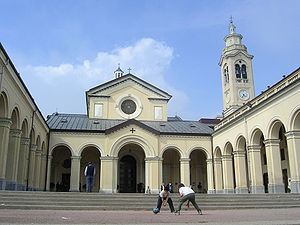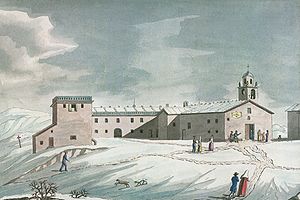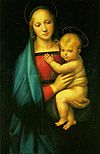- Shrine of Nostra Signora della Guardia
-
The “Shrine of Nostra Signora della Guardia” is a Catholic place of pilgrimage and is located on the top of Mount Figogna (804 m asl), in the Municipality of Ceranesi, about 20 km from the city of Genoa, in the northwest of Italy.
It is the most important Marian shrine in Liguria.
The name “Guardia” in Italian means “watch” and the shrine is so called because the Mount Figogna, in the Middle Ages was a strategic observation post to control displacement of armies along Valpolcevera and ships in the sea in front of Genoa. From the esplanade in front of the shrine, in a clear day, you can view all the underlying Polcevera valley and part of the city of Genoa and the Ligurian Riviera (and also, but only in a very clear day, mainly in winter, also the skyline of the mountains of the French island of Corse).
The Shrine is the destination of pilgrimages from Genoa and surroundings and all over Italy. The worship has been disseminated all over Italy and also abroad, so many churches and shrines have been consecrated to “Nostra Signora della Guardia”.
Contents
History
According to tradition, on August 29, 1490 the Virgin Mary appeared to a peasant calleed Benedetto Pareto and asked him to build a chapel on the mountain. Pareto was surprised and replied that he was only a poor man and would not be able to do that. But the Virgin Mary exhorted him by saying “Do not be afraid!”
Nevertheless, Pareto went home and did not speak with anyone about the apparition. A few days later he fell from a tree and was seriously injured. The Virgin Mary appeared to him again and he was miraculously healed. The event convinced him to speak about the apparition and seek help to build the chapel.
The first chapel
According to tradition, the first chapel was built by Pareto himself at the site of the apparition. It is a small rectangular building with a wooden roof, now inside the new chapel. Within a niche is a marble Madonna dated 1530.
The shrine
Due to the increasing flow of pilgrims a shrine was built on the top of the mountain between 1528 and 1530, thanks to a donation of the noble family Ghersi. Near the shrine was also built a hospice for the pilgrims, which was rebuilt at the end of the 18th century.
In the second half of the 19th century a new shrine was built. There were both technical and financial setbacks, but the church was completed in 1889 and inaugurated on May 26 1890.
In the following years the number of pilgrims continued to increase, so in 1903 the old church was demolished to make room for a new hospice and guesthouse for the pilgrims.
On March 11, 1915 the Genoese Pope Benedict XV assigned to the church the title of Basilica. Then, in 1917, the same pope built a small temple in the gardens of Vatican City where a statue of N.S. della Guardia (given to the Pope by Genoese people) was enshrined.
In 1929 a train (the “Autoguidovia”) was constructed, allowing pilgrims to reach the shrine from the bottom of the valley. Before this the only alternative was to go on foot. In 1963 a new road for vehicles was constructed (provincial road No 52 from Bolzaneto, 11 km long), and the “Autoguidovia”, considered uneconomic, was closed in 1967.
On September 22, 1985 the shrine was visited by Pope John Paul II. On May 18, 2008 the shrine was visited by Pope Benedict XVI.
Structure of the basilica
The new church was designed by Guglielmo Calmieri. It has a Latin cross shape with three aisles. The main aisle is painted with frescoes (1963) by the Genoese painter Antonio Santagata (1888-1985) with scenes of the life of the Virgin Mary. The frescoes in the dome, painted by the Lombard painter Pasquale Arzuffi (1897-1965), represent Mary surrounded by the Republic of Genoa patron saints.
In the church are also other statues representing the Virgin Mary and saints (St. John the Baptist, St. Joseph, St. Eusebius) and on the left of the high altar, a black procession crucifix.
A door in the left aisle leads to the hall of offerings, where hundreds of paintings, photos and objects have been left by people to express their gratitude to the Virgin Mary for having been curing or protecting them from illnesses, accidents, wars and shipwrecks.
See also
References
- Giovanni Meriana , Guida ai santuari della Liguria (Guide of shrines in Liguria), Sagep Editrice publisher, Genoa (Italy), 1990.
External links
General articles
Overview of Mariology •
Veneration of the Blessed Virgin • History of MariologyExpressions of devotion
Art • Hymns • Music • ArchitectureSpecific articles
Apparitions • Saints • Popes • Societies • Hearts of Jesus & Mary • Consecration to Mary- (Italian) Shrine of N.S. della Guardia Official Website
- (Italian) History of the shrine
- (Italian) Speech of Pope John Paul II when he visited the shrine in 1985
- (Italian) Hiking routes leading to the Shrine
- (Italian) Article about “Autoguidovia"
Categories:- Basilica churches in Italy
- Catholic pilgrimage sites
- Marian shrines
- Province of Genoa
Wikimedia Foundation. 2010.





